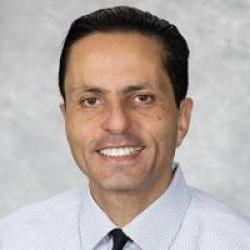A range of nonsurgical and surgical options
Patients come to Dr. Moussa and his colleagues for help with a variety of injuries or conditions, including knee or shoulder damage, ankle sprains or hip injuries.
He’s found that sometimes patients delay seeing a doctor when they first become injured because they don’t want to have surgery. However, there are many nonsurgical treatment options available to patients.
“I find that 90% of the time we can get the patient better without operating,” he says.
These noninvasive treatments include physical therapy, injection therapy, medications and lifestyle modifications.
When patients do need surgery, advancements in medical and surgical technologies mean most surgical patients experience shorter hospital stays, less blood loss, better pain management and a reduced need for pain medications.
Avoiding injury
Although not every injury is preventable, there are a few things you can do to reduce your chances of getting hurt.
“The best advice I can give is to maintain a general level of fitness and a healthy diet,” says Dr. Moussa.
That’s because exercise and proper nutrition can help you achieve a healthy weight, which puts less stress on the body’s musculoskeletal system. “This will mitigate the level of symptoms from any orthopedic state,” he adds.
When to see a doctor
Sometimes it’s obvious that you need to see a doctor—say if you hear a pop in your knee when you fall or you break a bone.
“In a traumatic injury situation, it’s easier to evaluate it earlier rather than later when more damage has occurred,” he cautions.
With chronic injuries, it’s not always clear cut. If rest, icing the injury, using compression and taking anti-inflammatory medication doesn’t help, it may be time to be evaluated by a healthcare provider.
“I always tell people to look at the trends,” advises Dr. Moussa. “If your symptoms continue to get worse and you are hurting more and more despite giving it a rest, then it’s time to see a doctor.”
“The best part of my job”
Dr. Moussa is dedicated to helping his patients achieve the best possible outcome so they can pursue their passions.
“I still say, 20 years into this, the best part of the job is when someone comes to me and says thank you, my pain is better, and I’m able to do what I wasn’t able to do before,” he says. “The fact that they’re able to return to what they love and think you played a part in it—that makes your day.”

